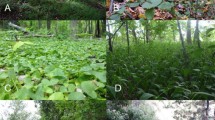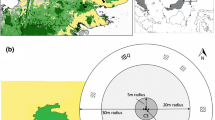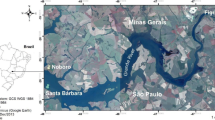Abstract
Temperate forests are relatively little affected by invasions globally. However, it remains unclear if these low invasion levels can be attributed to high invasion resistance, or if particularly long time lags in forests have lead to wide-spread invasion debt at the landscape and habitat scales, thus masking the invasibility of forests. Using linear and generalized linear mixed-effects models, we tested which factors determine the level of invasion of old (archaeophytes, pre-1500 alien species) and new (neophytes, post-1500 alien species) invaders across 30 study sites (5 ha size) and 16 transects in lowland forests in eastern Austria, Central Europe. We analysed the importance of different forest types, adjacent habitats, introduction pathways, species’ local residence time and proximity to human settlements as proxy for propagule pressure. We recorded 109 neophyte and 50 archaeophyte species, with significant differences between both groups with respect to region of origin, pathways, and life form. The number of neophyte species per study site varied by more than an order of magnitude and was dependent on both proximity to settlements and residence time in a non-linear manner, with proximity to settlements showing a particularly strong effect for recently introduced neophytes. In contrast, archaeophyte species numbers were only marginally affected by distance to the nearest settlement. Within habitats, transect plots close to the forest edge and adjacent to settlements showed significantly higher numbers and cover of neophyte species, whereas for archaeophytes and native species no such effect could be detected. Our results suggest that time lag phenomena stemming from dispersal limitation (e.g. aggravated by isolation of forest patches), heterogeneity in species’ local residence time as well as increases in local levels of propagule pressure (e.g. created by expanding settlements), may result in wide-spread invasion debt at the landscape and habitat scales, hence masking invasibility of forests. Spread of new invaders may ultimately, although possibly only over long time periods, result in increased frequency and impact of neophyte species in temperate forests.


Similar content being viewed by others
References
AliensAustria (2010) Austrian database of alien plant, animal and fungi species. Umweltbundesamt, Vienna Accessed 15 September 2010
Bates D, Maechler M, Bolker B (2011) lme4: linear mixed-effects models using S4 classes. http://CRAN.R-project.org/package=lme4
Botham MS, Rothery P, Hulme PE et al (2009) Do urban areas act as foci for the spread of alien plant species? An assessment of temporal trends in the UK. Divers Distrib 15:338–345
Bucharova A, van Kleunen M (2009) Introduction history and species characteristics partly explain naturalization success of North American woody species in Europe. J Ecol 97:230–238
Chytrý M, Pyšek P, Tichy L, Knollova I, Danihelka J (2005) Invasions by alien plants in the Czech Republic: a quantitative assessment across habitats. Preslia 77:339–354
Chytrý M, Maskell LC, Pino J et al (2008a) Habitat invasions by alien plants: a quantitative comparison among Mediterranean, subcontinental and oceanic regions of Europe. J Appl Ecol 45:448–458
Chytrý M, Jarosik V, Pyšek P et al (2008b) Separating habitat invasibility by alien plants from the actual level of invasion. Ecology 89:1541–1553
Colautti RI, Grigorovich IA, MacIsaac HJ (2006) Propagule pressure: a null model for biological invasions. Biol Invas 8:1023–1037
Daehler CC (2009) Short lag times for invasive tropical plants: evidence from experimental plantings in Hawai’i. PLoS ONE 4(2):e4462. doi:10.1371/journal.pone.0004462
Davis MA, Grime JP, Thompson K (2000) Fluctuating resources in plant communities: a general theory of invasibility. J Ecol 88:528–534
Dehnen-Schmutz K (2004) Alien species reflecting history: medieval castles in Germany. Divers Distrib 10:147–151
Dehnen-Schmutz K, Touza J, Perrings C, Williamson M (2007a) The horticultural trade and ornamental plant invasions in Britain. Conserv Biol 21:224–231
Dehnen-Schmutz K, Touza J, Perrings C, Williamson M (2007b) A century of the ornamental plant trade and its impact on invasion success. Divers Distrib 13:527–534
Dietz HJ, Edwards PJ (2004) Recognition that causal processes change during plant invasion helps to explain conflicts in evidence. Ecology 87:1359–1367
Essl F, Rabitsch W (2002) Neobiota in Österreich. Umweltbundesamt, Vienna
Essl F, Dullinger S, Rabitsch W et al (2011a) Socioeconomic legacy yields an invasion debt. Proc Natl Acad Sci 108:203–207
Essl F, Milasowszky N, Dirnböck T (2011b) Plant invasions in temperate forests: resistance or ephemeral phenomenon? Basic Appl Ecol 12:1–9
Faraway JJ (2006) Extending the linear model with R: generalized linear, mixed effects and nonparametric regression models. Chapman and Hall, Boca Raton
Fischer MA, Adler W, Oswald K (2008) Exkursionsflora für Österreich, Liechtenstein und Südtirol. Biologiezentrum Oberösterreich, Linz
Gustafson EJ, Parker GR (1992) Relationships between landcover proportions and indices of landscape spatial pattern. Landscape Ecol 7:101–110
Kleinbauer I, Dullinger S, Peterseil J, Essl F (2009) Climate change might drive the invasive tree Robinia pseudacacia into nature reserves and endangered habitats. Biol Conserv 143:382–390
Kowarik I (1992) Einführung und Ausbreitung nichtheimischer Gehölzarten in Berlin und Brandenburg und ihre Folgen für Flora und Vegetation. Verhandlungen des botanischen Vereins Berlin Brandenburg, Beiheft 3:1–180
Kowarik I (1995) Time lags in biological invasions with regard to the success and failure of alien species. In: Pyšek P, Prach K, Rejmánek M, Wade M (eds) Plant invasions: general aspects and special problems. SPB Academic Publishing, The Hague, pp 15–38
Kowarik I (2003a) Biologische Invasionen: Neophyten und Neozoen in Mitteleuropa. E. Ulmer Verlag, Stuttgart
Kowarik I (2003b) Human agency in biological invasions: secondary releases foster naturalisation and population expansion of alien plant species. Biol Invasions 5:281–300
Lambdon PW, Pyšek P, Basnou C et al (2008) Alien flora of Europe: species diversity, temporal trends, geographical patterns and research needs. Preslia 80:101–149
Lockwood JL, Cassey P, Blackburn T (2005) The role of propagule pressure in explaining species invasions. Trends Ecol Evol 20:223–228
Loram A, Thompson K, Warren PH, Gaston KJ (2008) Urban domestic gardens (XII): the richness and composition of the flora in five UK cities. J Veg Sci 19:321–330
Martin PH, Canham CD, Marks PL (2009) Why forests appear resistant to exotic plant invasions: intentional introductions, stand dynamics, and the role of shade tolerance. Frontiers Ecol Environ 7:142–149
Montgomery DC, Peck EA, Vining GG (2001) Introduction to linear regression analysis, 3rd edn. John Wiley and Sons Inc., New York
Preston CD, Pearman DA, Hall AR (2004) Archaeophytes in Britain. Bot J Linn Soc 145:257–294
Pyšek P, Richardson DM (2007) Traits associated with invasiveness: where do we stand? In: Nentwig W (ed) Biological invasions. Springer, Berlin, pp 97–122
Pyšek P, Kucera T, Jarošik V (2002) Plant species richness of nature reserves: the interplay of area, climate and habitat in a central European landscape. Global Ecol Biogeograp 11:279–289
Pyšek P, Krivanek M, Jarošik V (2009) Planting intensity, residence time, and species traits determine invasion success of alien woody species. Ecology 90:2734–2744
Pyšek P, Krivanek M, Jarošik V et al (2010) Disentangling the role of environmental and human pressures on biological invasions across Europe. Proc Natl Acad Sci 107:12157–12162
Rabitsch W, Essl F (2006) Biological invasions in Austria: patterns and case studies. Biol Invasions 8:295–308
R Development Core Team (2011) R: a language and environment for statistical computing. R Foundation for Statistical Computing, Vienna, Austria. http://www.R-project.org
Richardson DM, Pyšek P, Rejmánek M et al (2000) Naturalisation and invasion of alien plants: concepts and definitions. Divers Distrib 6:93–107
Smith RM, Thompson K, Hodgson JG et al (2006) Urban domestic gardens (IX): composition and richness of the vascular plant flora, and implications for native biodiversity. Biol Conserv 129:312–322
Sullivan J, Timmins SM, Williams PA (2005) Movement of exotic plants into coastal native forests from gardens in northern New Zealand. New Zealand J Ecol 29:1–10
Svenning JC, Skov F (2004) Limited filling of the potential range in European tree species. Ecol Lett 7:565–573
Svenning JC, Skov F (2007) Could the tree diversity pattern in Europe be generated by postglacial dispersal limitation? Ecol Lett 10:453–460
Von Holle B, Simberloff D (2005) Ecological resistance to biological invasion overwhelmed by propagule pressure. Ecology 86:3212–3218
Walter J, Essl F, Englisch T, Kiehn M (2005) Neophytes in Austria: habitat preferences and ecological effects. Neobiota 6:13–25
Wiesbauer H and Mazucco K (1997) Dünen in Niederösterreich. Fachberichte des NÖ Landschaftsfonds 6:1–91
Acknowledgments
We are grateful to Christian Schröck and Oliver Stöhr for their assistance in determining critical specimens. We greatly appreciate comments from the associate editor, Marc Cadotte, and from two anonymous reviewers, which helped to improve the manuscript.
Author information
Authors and Affiliations
Corresponding author
Electronic supplementary material
Below is the link to the electronic supplementary material.
10530_2011_156_MOESM1_ESM.doc
Appendix S1: Forest types (in % of total area), identity of adjacent habitat types (1 = present, 0 = absent) and total number of adjacent habitat types, minimum distance to the next settlement, and total neophyte and archaeophyte species numbers in the 30 study sites. Abbreviations: native broadl. for. = native broadleaved forests dominated by oaks (Quercus cerris, Q. petraea, Q. robur); conifer for. = native conifer plantations (Pinus nigra, P. sylvestris); alien broadl. for. = forests dominated by alien broadleaved trees (Ailanthus altissima, Robinia pseudacacia). Supplementary material 1 (DOC 95 kb)
10530_2011_156_MOESM2_ESM.doc
Appendix S2: Neophyte flora of the 30 study sites. Given are taxon name, year of first record in Austria (year), pathway (hort = horticulture, for = forestry, unint = unintentional), origin (NA = North America, AS = Asia, cult = originated in horticulture - anecophytes, EU = Europe), life form (ll = long-lived herb, tr = tree, sh = shrub, sl = short-lived herb). Occurrence in the forest patches is recorded in five logarithmic abundance classes (VC = very common, i.e. >10% plant cover; CO = common, i.e. 1-10% plant cover; SC = scattered, i.e. 0.1-1% plant cover; RA = rare, i.e. few individuals with 0.1-0.01% plant cover; VR = very rare, i.e. very few individuals with very low plant cover, <0.01) and total number of colonized sites (no). Supplementary material 2 (DOC 610 kb)
10530_2011_156_MOESM3_ESM.doc
Appendix S3: Archaeophyte flora of the 30 study sites. Given are taxon name, pathway (hort = horticulture, agri = agriculture, unint = unintentional), origin (EU = Europe), life form (ll = long-lived herb, tr = tree, sh = shrub, sl = short-lived herb). Occurrence in the forest patches is recorded in five logarithmic abundance classes (VC = very common, i.e. >10% plant cover; CO = common, i.e. 1-10% plant cover; SC = scattered, i.e. 0.1-1% plant cover; RA = rare, i.e. few individuals with 0.1-0.01% plant cover; VR = very rare, i.e. very few individuals with very low plant cover, <0.01) and total number of colonized sites (no). Supplementary material 3 (DOC 283 kb)
10530_2011_156_MOESM4_ESM.doc
Appendix S4: Plant species data of the 16 transects. Each transect consists of five plots, which are labelled one to five with increasing distance from the forest edge. Plant species cover is given in %, cover is assessed separately for herb, shrub and tree layers. Further, floristic status (native, archaeophyte, neophyte), residence time in Austria, the dominant pathway, region of origin, and the life form are given. Abbreviations: TL = tree layer, SL = shrub layer, HL = herb layer. Supplementary material 4 (DOC 159 kb)
10530_2011_156_MOESM5_ESM.doc
Appendix S5: The linear mixed-effects models (LMMs) for alien (archaeophytes, neophytes) (A) and native (B) species total plant cover in the transect plots. Analyses were restricted to species present at each plot. Estimated standard deviations of random-effect intercepts and residual term: alien species: transect: 0.15, plot: < 0.01, species: 0.57, residual: 0.82; native species: transect: 0.15, plot: < 0.01, species: 0.55, residual: 0.82. Supplementary material 5 (DOC 43 kb)
10530_2011_156_MOESM6_ESM.doc
Appendix S6: The linear mixed-effects models (LMMs) for alien (archaeophytes, neophytes) (A) and native (B) species herb-layer cover in the transect plots. Analyses were restricted to species present at each plot. Standard deviations of random-effect intercepts and residual term: alien species: transect: 0.07, plot: < 0.01, species: 0.45, residual: 0.70; native species: transect: 0.09, plot: < 0.01, species: 0.46, residual: 0.64. Supplementary material 6 (DOC 42 kb)
Rights and permissions
About this article
Cite this article
Essl, F., Mang, T. & Moser, D. Ancient and recent alien species in temperate forests: steady state and time lags. Biol Invasions 14, 1331–1342 (2012). https://doi.org/10.1007/s10530-011-0156-y
Received:
Accepted:
Published:
Issue Date:
DOI: https://doi.org/10.1007/s10530-011-0156-y




